A Case Study on Research Methodology: Cloud Computing Security Issues
VerifiedAdded on 2020/04/21
|21
|4342
|218
Report
AI Summary
This report presents a comprehensive analysis of cloud computing security, focusing on research methodology and a case study approach. It begins with an introduction that highlights the importance of secure data storage and management in the cloud, followed by a scope outlining the areas of investigation, including network, storage, and data security. The literature review explores cloud features, risks such as security breaches and compliance issues, and research gaps. The methodology section details the research approach, strategy, data collection, and ethical considerations. The report identifies the security issues associated with cloud computing and recommends possible measures to mitigate the issues, such as multi-tenancy and information integrity. It also discusses the importance of addressing third-party control and disaster recovery plans. The report concludes with a summary of the key findings and implications, emphasizing the need for ongoing research and proactive security measures to protect cloud-based data and systems. This assignment is available on Desklib, a platform providing AI-based study tools for students.
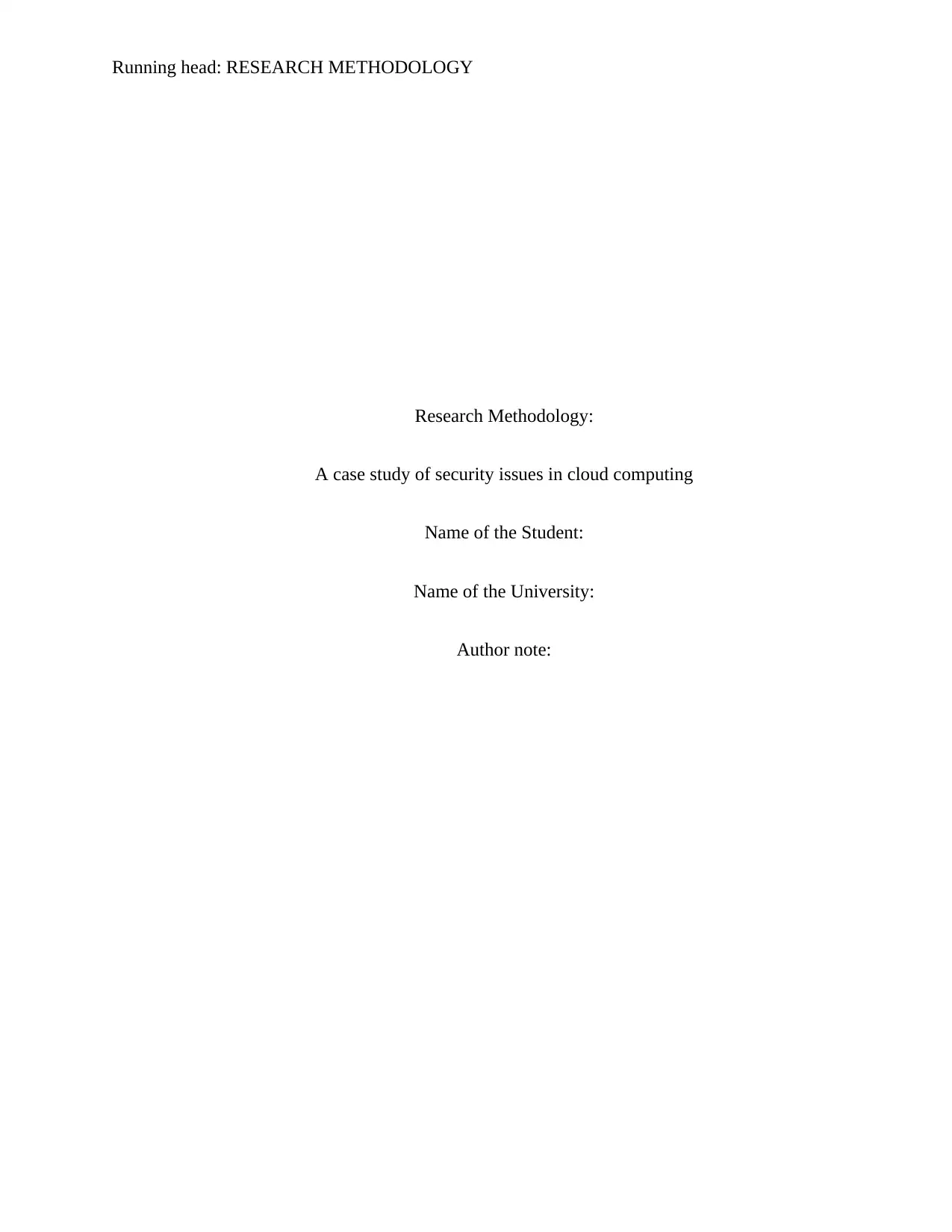
Running head: RESEARCH METHODOLOGY
Research Methodology:
A case study of security issues in cloud computing
Name of the Student:
Name of the University:
Author note:
Research Methodology:
A case study of security issues in cloud computing
Name of the Student:
Name of the University:
Author note:
Paraphrase This Document
Need a fresh take? Get an instant paraphrase of this document with our AI Paraphraser
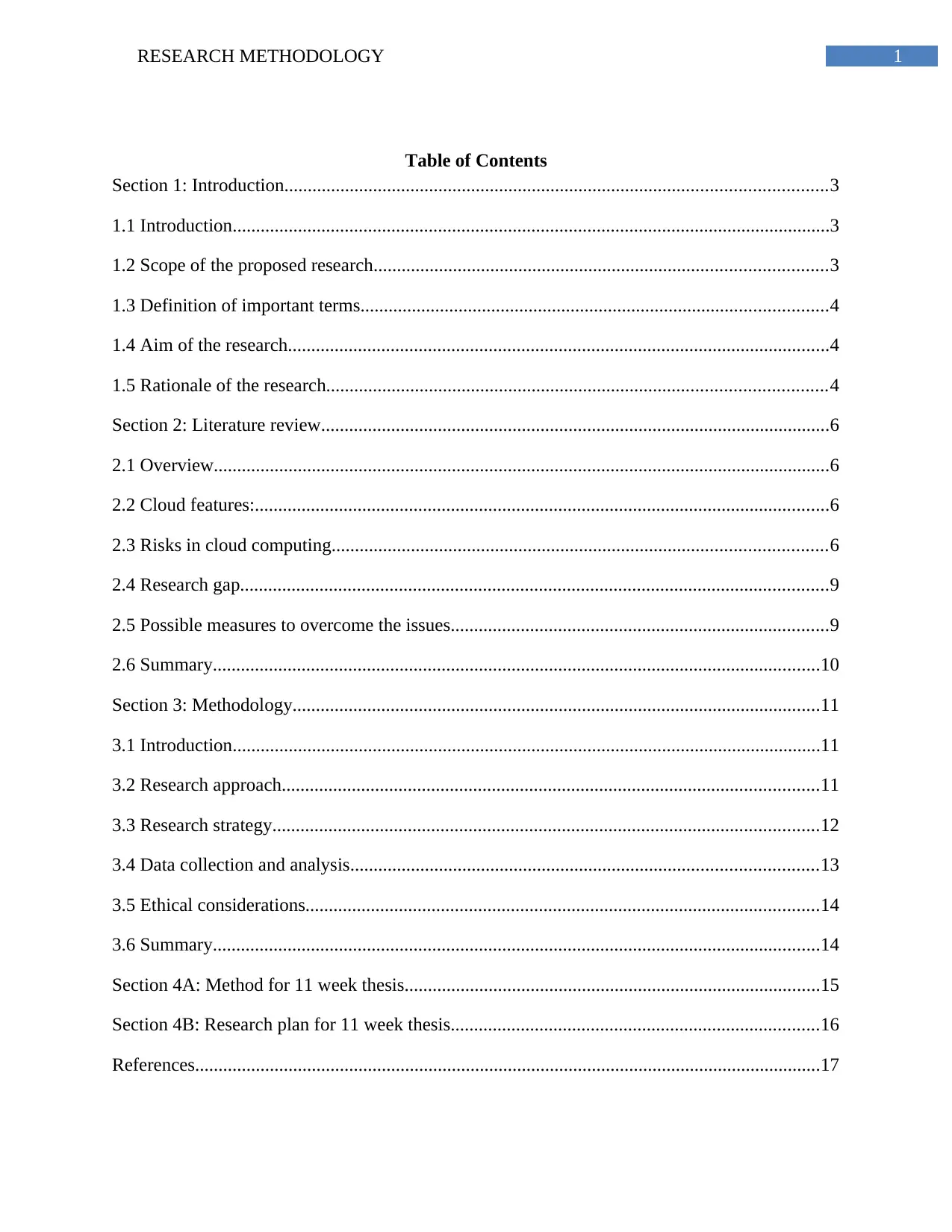
1RESEARCH METHODOLOGY
Table of Contents
Section 1: Introduction....................................................................................................................3
1.1 Introduction................................................................................................................................3
1.2 Scope of the proposed research.................................................................................................3
1.3 Definition of important terms....................................................................................................4
1.4 Aim of the research....................................................................................................................4
1.5 Rationale of the research...........................................................................................................4
Section 2: Literature review.............................................................................................................6
2.1 Overview....................................................................................................................................6
2.2 Cloud features:...........................................................................................................................6
2.3 Risks in cloud computing..........................................................................................................6
2.4 Research gap..............................................................................................................................9
2.5 Possible measures to overcome the issues.................................................................................9
2.6 Summary..................................................................................................................................10
Section 3: Methodology.................................................................................................................11
3.1 Introduction..............................................................................................................................11
3.2 Research approach...................................................................................................................11
3.3 Research strategy.....................................................................................................................12
3.4 Data collection and analysis....................................................................................................13
3.5 Ethical considerations..............................................................................................................14
3.6 Summary..................................................................................................................................14
Section 4A: Method for 11 week thesis.........................................................................................15
Section 4B: Research plan for 11 week thesis...............................................................................16
References......................................................................................................................................17
Table of Contents
Section 1: Introduction....................................................................................................................3
1.1 Introduction................................................................................................................................3
1.2 Scope of the proposed research.................................................................................................3
1.3 Definition of important terms....................................................................................................4
1.4 Aim of the research....................................................................................................................4
1.5 Rationale of the research...........................................................................................................4
Section 2: Literature review.............................................................................................................6
2.1 Overview....................................................................................................................................6
2.2 Cloud features:...........................................................................................................................6
2.3 Risks in cloud computing..........................................................................................................6
2.4 Research gap..............................................................................................................................9
2.5 Possible measures to overcome the issues.................................................................................9
2.6 Summary..................................................................................................................................10
Section 3: Methodology.................................................................................................................11
3.1 Introduction..............................................................................................................................11
3.2 Research approach...................................................................................................................11
3.3 Research strategy.....................................................................................................................12
3.4 Data collection and analysis....................................................................................................13
3.5 Ethical considerations..............................................................................................................14
3.6 Summary..................................................................................................................................14
Section 4A: Method for 11 week thesis.........................................................................................15
Section 4B: Research plan for 11 week thesis...............................................................................16
References......................................................................................................................................17
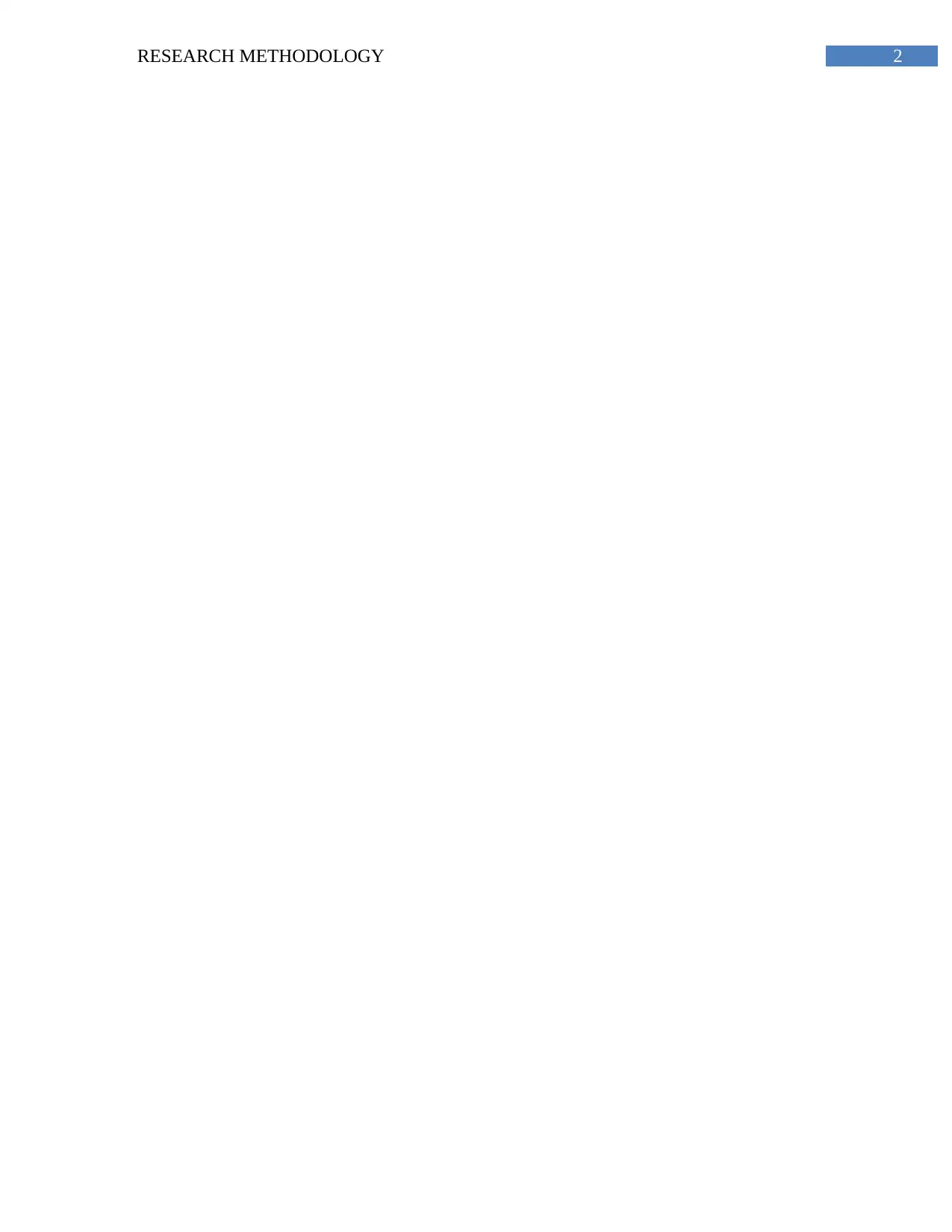
2RESEARCH METHODOLOGY
⊘ This is a preview!⊘
Do you want full access?
Subscribe today to unlock all pages.

Trusted by 1+ million students worldwide
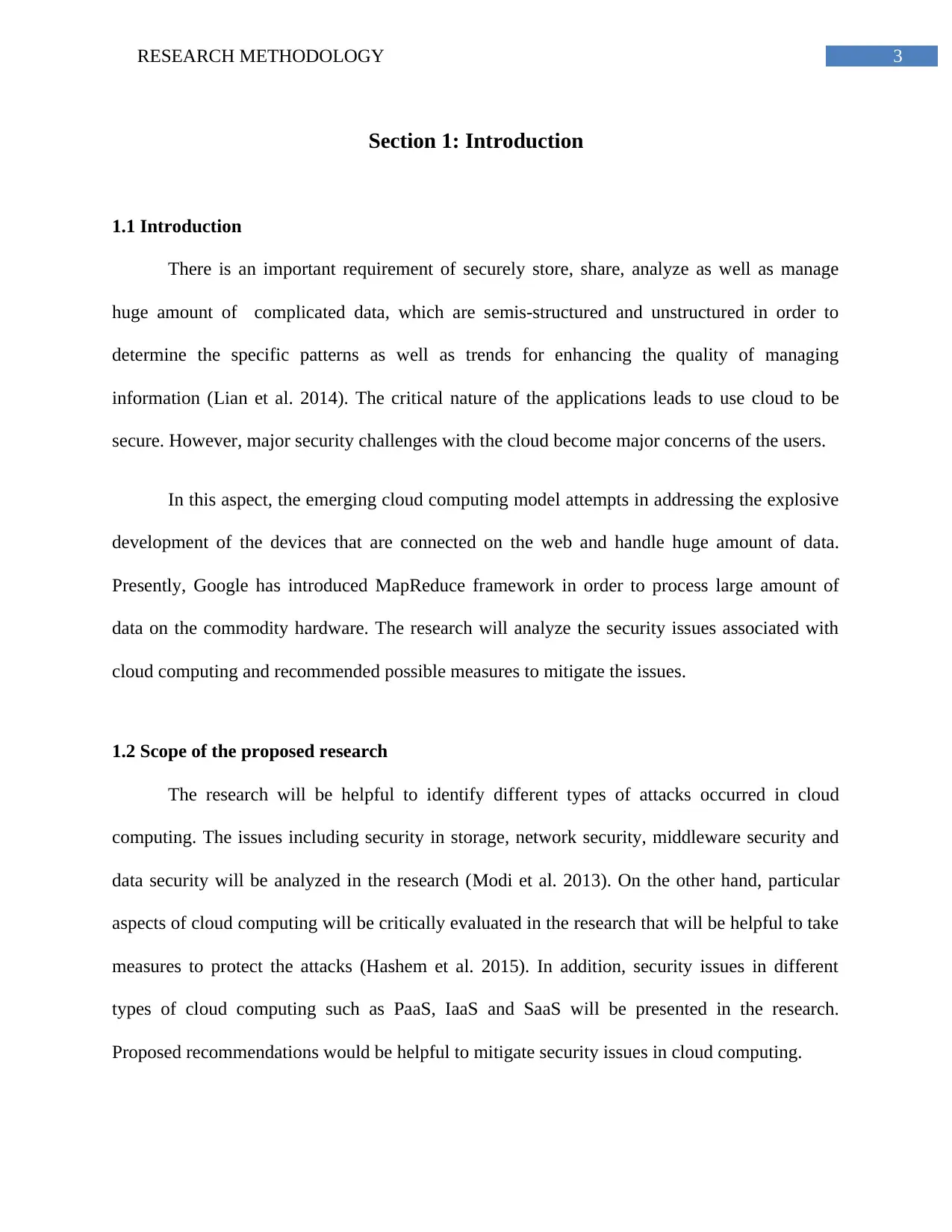
3RESEARCH METHODOLOGY
Section 1: Introduction
1.1 Introduction
There is an important requirement of securely store, share, analyze as well as manage
huge amount of complicated data, which are semis-structured and unstructured in order to
determine the specific patterns as well as trends for enhancing the quality of managing
information (Lian et al. 2014). The critical nature of the applications leads to use cloud to be
secure. However, major security challenges with the cloud become major concerns of the users.
In this aspect, the emerging cloud computing model attempts in addressing the explosive
development of the devices that are connected on the web and handle huge amount of data.
Presently, Google has introduced MapReduce framework in order to process large amount of
data on the commodity hardware. The research will analyze the security issues associated with
cloud computing and recommended possible measures to mitigate the issues.
1.2 Scope of the proposed research
The research will be helpful to identify different types of attacks occurred in cloud
computing. The issues including security in storage, network security, middleware security and
data security will be analyzed in the research (Modi et al. 2013). On the other hand, particular
aspects of cloud computing will be critically evaluated in the research that will be helpful to take
measures to protect the attacks (Hashem et al. 2015). In addition, security issues in different
types of cloud computing such as PaaS, IaaS and SaaS will be presented in the research.
Proposed recommendations would be helpful to mitigate security issues in cloud computing.
Section 1: Introduction
1.1 Introduction
There is an important requirement of securely store, share, analyze as well as manage
huge amount of complicated data, which are semis-structured and unstructured in order to
determine the specific patterns as well as trends for enhancing the quality of managing
information (Lian et al. 2014). The critical nature of the applications leads to use cloud to be
secure. However, major security challenges with the cloud become major concerns of the users.
In this aspect, the emerging cloud computing model attempts in addressing the explosive
development of the devices that are connected on the web and handle huge amount of data.
Presently, Google has introduced MapReduce framework in order to process large amount of
data on the commodity hardware. The research will analyze the security issues associated with
cloud computing and recommended possible measures to mitigate the issues.
1.2 Scope of the proposed research
The research will be helpful to identify different types of attacks occurred in cloud
computing. The issues including security in storage, network security, middleware security and
data security will be analyzed in the research (Modi et al. 2013). On the other hand, particular
aspects of cloud computing will be critically evaluated in the research that will be helpful to take
measures to protect the attacks (Hashem et al. 2015). In addition, security issues in different
types of cloud computing such as PaaS, IaaS and SaaS will be presented in the research.
Proposed recommendations would be helpful to mitigate security issues in cloud computing.
Paraphrase This Document
Need a fresh take? Get an instant paraphrase of this document with our AI Paraphraser
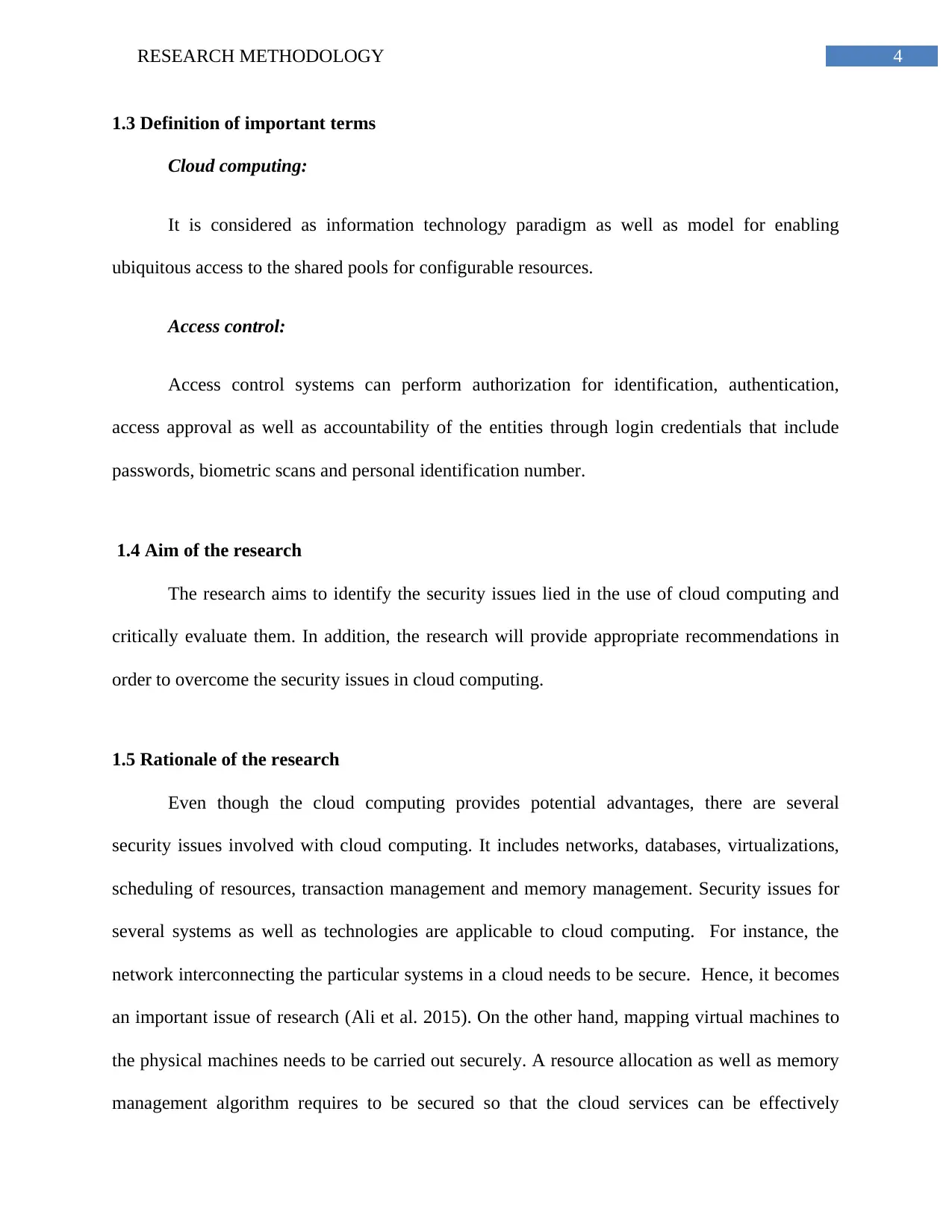
4RESEARCH METHODOLOGY
1.3 Definition of important terms
Cloud computing:
It is considered as information technology paradigm as well as model for enabling
ubiquitous access to the shared pools for configurable resources.
Access control:
Access control systems can perform authorization for identification, authentication,
access approval as well as accountability of the entities through login credentials that include
passwords, biometric scans and personal identification number.
1.4 Aim of the research
The research aims to identify the security issues lied in the use of cloud computing and
critically evaluate them. In addition, the research will provide appropriate recommendations in
order to overcome the security issues in cloud computing.
1.5 Rationale of the research
Even though the cloud computing provides potential advantages, there are several
security issues involved with cloud computing. It includes networks, databases, virtualizations,
scheduling of resources, transaction management and memory management. Security issues for
several systems as well as technologies are applicable to cloud computing. For instance, the
network interconnecting the particular systems in a cloud needs to be secure. Hence, it becomes
an important issue of research (Ali et al. 2015). On the other hand, mapping virtual machines to
the physical machines needs to be carried out securely. A resource allocation as well as memory
management algorithm requires to be secured so that the cloud services can be effectively
1.3 Definition of important terms
Cloud computing:
It is considered as information technology paradigm as well as model for enabling
ubiquitous access to the shared pools for configurable resources.
Access control:
Access control systems can perform authorization for identification, authentication,
access approval as well as accountability of the entities through login credentials that include
passwords, biometric scans and personal identification number.
1.4 Aim of the research
The research aims to identify the security issues lied in the use of cloud computing and
critically evaluate them. In addition, the research will provide appropriate recommendations in
order to overcome the security issues in cloud computing.
1.5 Rationale of the research
Even though the cloud computing provides potential advantages, there are several
security issues involved with cloud computing. It includes networks, databases, virtualizations,
scheduling of resources, transaction management and memory management. Security issues for
several systems as well as technologies are applicable to cloud computing. For instance, the
network interconnecting the particular systems in a cloud needs to be secure. Hence, it becomes
an important issue of research (Ali et al. 2015). On the other hand, mapping virtual machines to
the physical machines needs to be carried out securely. A resource allocation as well as memory
management algorithm requires to be secured so that the cloud services can be effectively
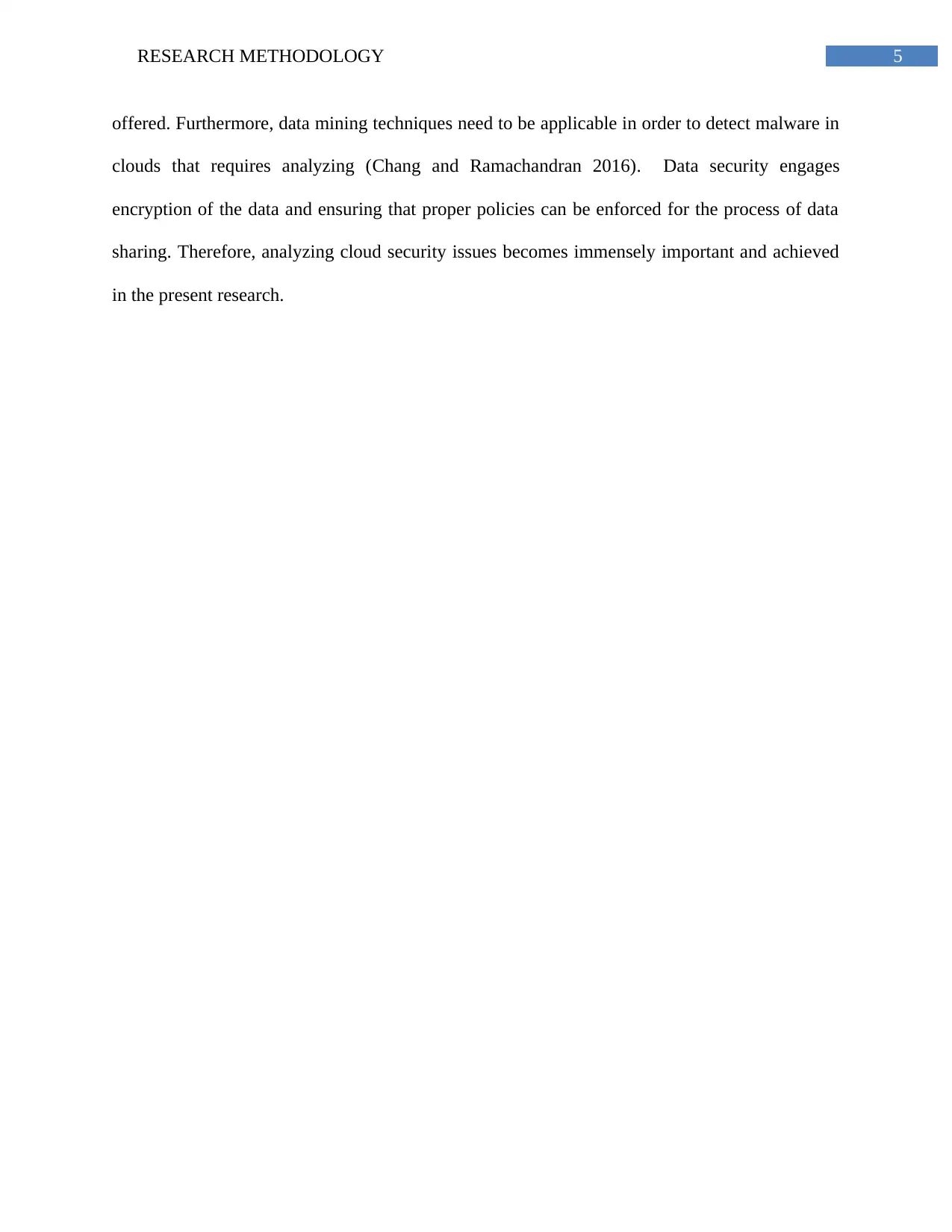
5RESEARCH METHODOLOGY
offered. Furthermore, data mining techniques need to be applicable in order to detect malware in
clouds that requires analyzing (Chang and Ramachandran 2016). Data security engages
encryption of the data and ensuring that proper policies can be enforced for the process of data
sharing. Therefore, analyzing cloud security issues becomes immensely important and achieved
in the present research.
offered. Furthermore, data mining techniques need to be applicable in order to detect malware in
clouds that requires analyzing (Chang and Ramachandran 2016). Data security engages
encryption of the data and ensuring that proper policies can be enforced for the process of data
sharing. Therefore, analyzing cloud security issues becomes immensely important and achieved
in the present research.
⊘ This is a preview!⊘
Do you want full access?
Subscribe today to unlock all pages.

Trusted by 1+ million students worldwide
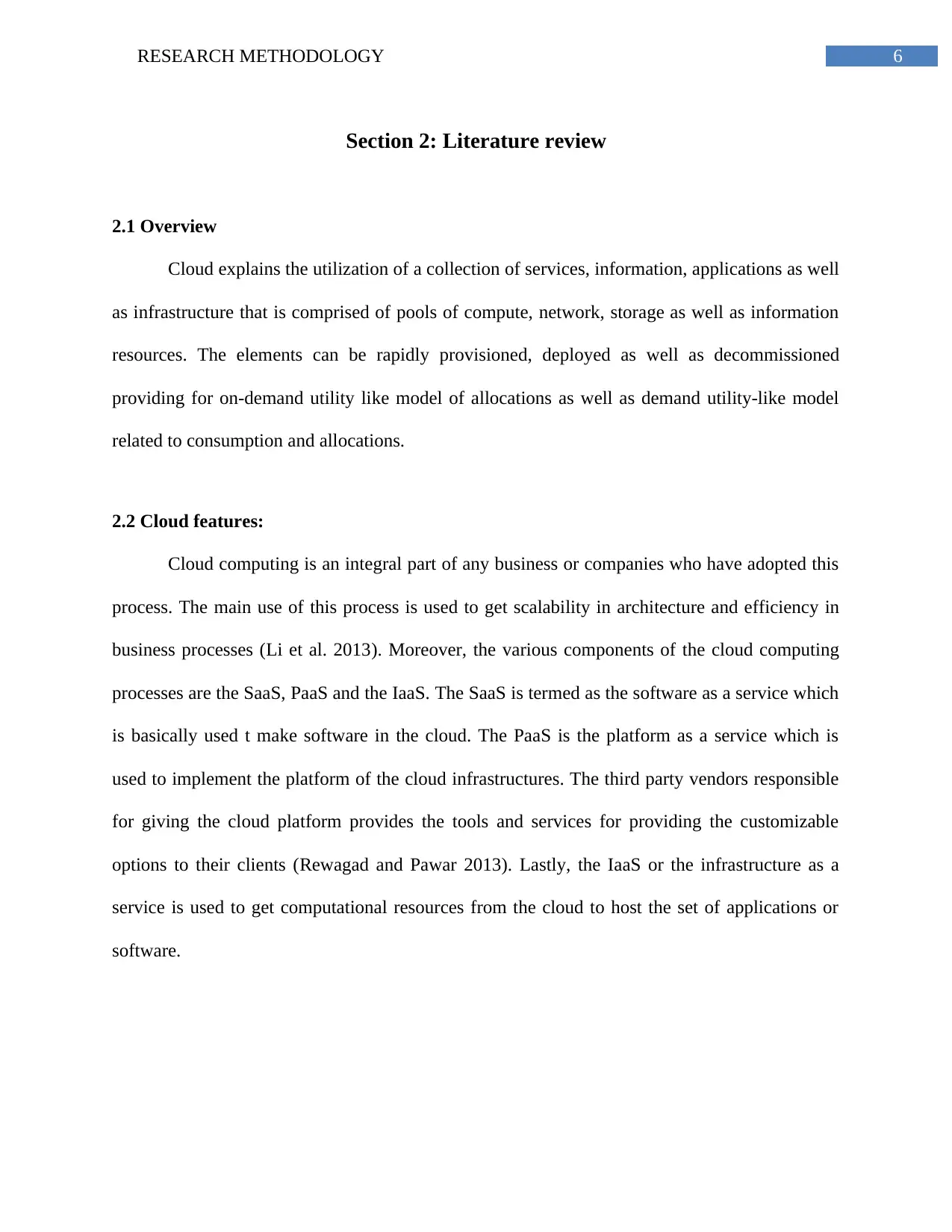
6RESEARCH METHODOLOGY
Section 2: Literature review
2.1 Overview
Cloud explains the utilization of a collection of services, information, applications as well
as infrastructure that is comprised of pools of compute, network, storage as well as information
resources. The elements can be rapidly provisioned, deployed as well as decommissioned
providing for on-demand utility like model of allocations as well as demand utility-like model
related to consumption and allocations.
2.2 Cloud features:
Cloud computing is an integral part of any business or companies who have adopted this
process. The main use of this process is used to get scalability in architecture and efficiency in
business processes (Li et al. 2013). Moreover, the various components of the cloud computing
processes are the SaaS, PaaS and the IaaS. The SaaS is termed as the software as a service which
is basically used t make software in the cloud. The PaaS is the platform as a service which is
used to implement the platform of the cloud infrastructures. The third party vendors responsible
for giving the cloud platform provides the tools and services for providing the customizable
options to their clients (Rewagad and Pawar 2013). Lastly, the IaaS or the infrastructure as a
service is used to get computational resources from the cloud to host the set of applications or
software.
Section 2: Literature review
2.1 Overview
Cloud explains the utilization of a collection of services, information, applications as well
as infrastructure that is comprised of pools of compute, network, storage as well as information
resources. The elements can be rapidly provisioned, deployed as well as decommissioned
providing for on-demand utility like model of allocations as well as demand utility-like model
related to consumption and allocations.
2.2 Cloud features:
Cloud computing is an integral part of any business or companies who have adopted this
process. The main use of this process is used to get scalability in architecture and efficiency in
business processes (Li et al. 2013). Moreover, the various components of the cloud computing
processes are the SaaS, PaaS and the IaaS. The SaaS is termed as the software as a service which
is basically used t make software in the cloud. The PaaS is the platform as a service which is
used to implement the platform of the cloud infrastructures. The third party vendors responsible
for giving the cloud platform provides the tools and services for providing the customizable
options to their clients (Rewagad and Pawar 2013). Lastly, the IaaS or the infrastructure as a
service is used to get computational resources from the cloud to host the set of applications or
software.
Paraphrase This Document
Need a fresh take? Get an instant paraphrase of this document with our AI Paraphraser
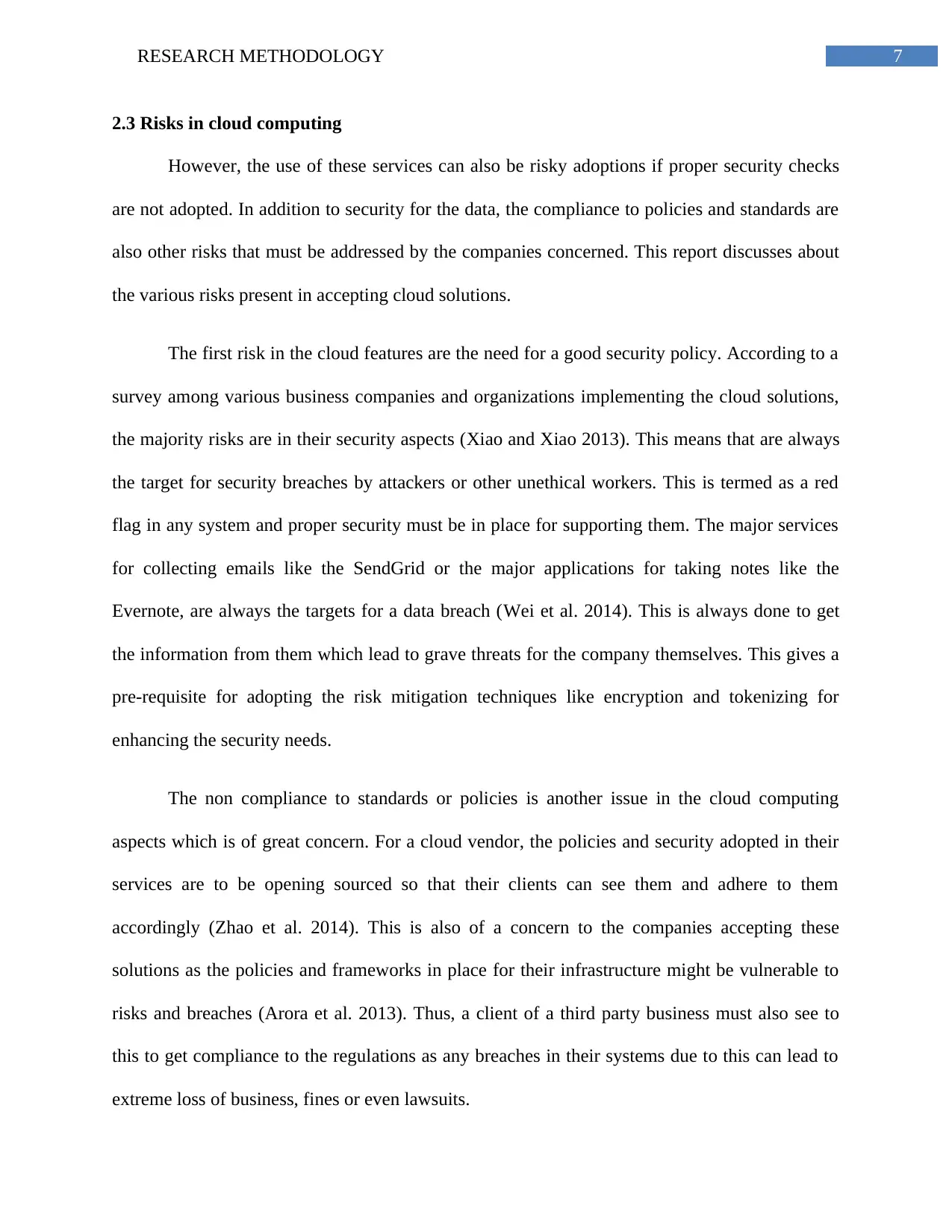
7RESEARCH METHODOLOGY
2.3 Risks in cloud computing
However, the use of these services can also be risky adoptions if proper security checks
are not adopted. In addition to security for the data, the compliance to policies and standards are
also other risks that must be addressed by the companies concerned. This report discusses about
the various risks present in accepting cloud solutions.
The first risk in the cloud features are the need for a good security policy. According to a
survey among various business companies and organizations implementing the cloud solutions,
the majority risks are in their security aspects (Xiao and Xiao 2013). This means that are always
the target for security breaches by attackers or other unethical workers. This is termed as a red
flag in any system and proper security must be in place for supporting them. The major services
for collecting emails like the SendGrid or the major applications for taking notes like the
Evernote, are always the targets for a data breach (Wei et al. 2014). This is always done to get
the information from them which lead to grave threats for the company themselves. This gives a
pre-requisite for adopting the risk mitigation techniques like encryption and tokenizing for
enhancing the security needs.
The non compliance to standards or policies is another issue in the cloud computing
aspects which is of great concern. For a cloud vendor, the policies and security adopted in their
services are to be opening sourced so that their clients can see them and adhere to them
accordingly (Zhao et al. 2014). This is also of a concern to the companies accepting these
solutions as the policies and frameworks in place for their infrastructure might be vulnerable to
risks and breaches (Arora et al. 2013). Thus, a client of a third party business must also see to
this to get compliance to the regulations as any breaches in their systems due to this can lead to
extreme loss of business, fines or even lawsuits.
2.3 Risks in cloud computing
However, the use of these services can also be risky adoptions if proper security checks
are not adopted. In addition to security for the data, the compliance to policies and standards are
also other risks that must be addressed by the companies concerned. This report discusses about
the various risks present in accepting cloud solutions.
The first risk in the cloud features are the need for a good security policy. According to a
survey among various business companies and organizations implementing the cloud solutions,
the majority risks are in their security aspects (Xiao and Xiao 2013). This means that are always
the target for security breaches by attackers or other unethical workers. This is termed as a red
flag in any system and proper security must be in place for supporting them. The major services
for collecting emails like the SendGrid or the major applications for taking notes like the
Evernote, are always the targets for a data breach (Wei et al. 2014). This is always done to get
the information from them which lead to grave threats for the company themselves. This gives a
pre-requisite for adopting the risk mitigation techniques like encryption and tokenizing for
enhancing the security needs.
The non compliance to standards or policies is another issue in the cloud computing
aspects which is of great concern. For a cloud vendor, the policies and security adopted in their
services are to be opening sourced so that their clients can see them and adhere to them
accordingly (Zhao et al. 2014). This is also of a concern to the companies accepting these
solutions as the policies and frameworks in place for their infrastructure might be vulnerable to
risks and breaches (Arora et al. 2013). Thus, a client of a third party business must also see to
this to get compliance to the regulations as any breaches in their systems due to this can lead to
extreme loss of business, fines or even lawsuits.
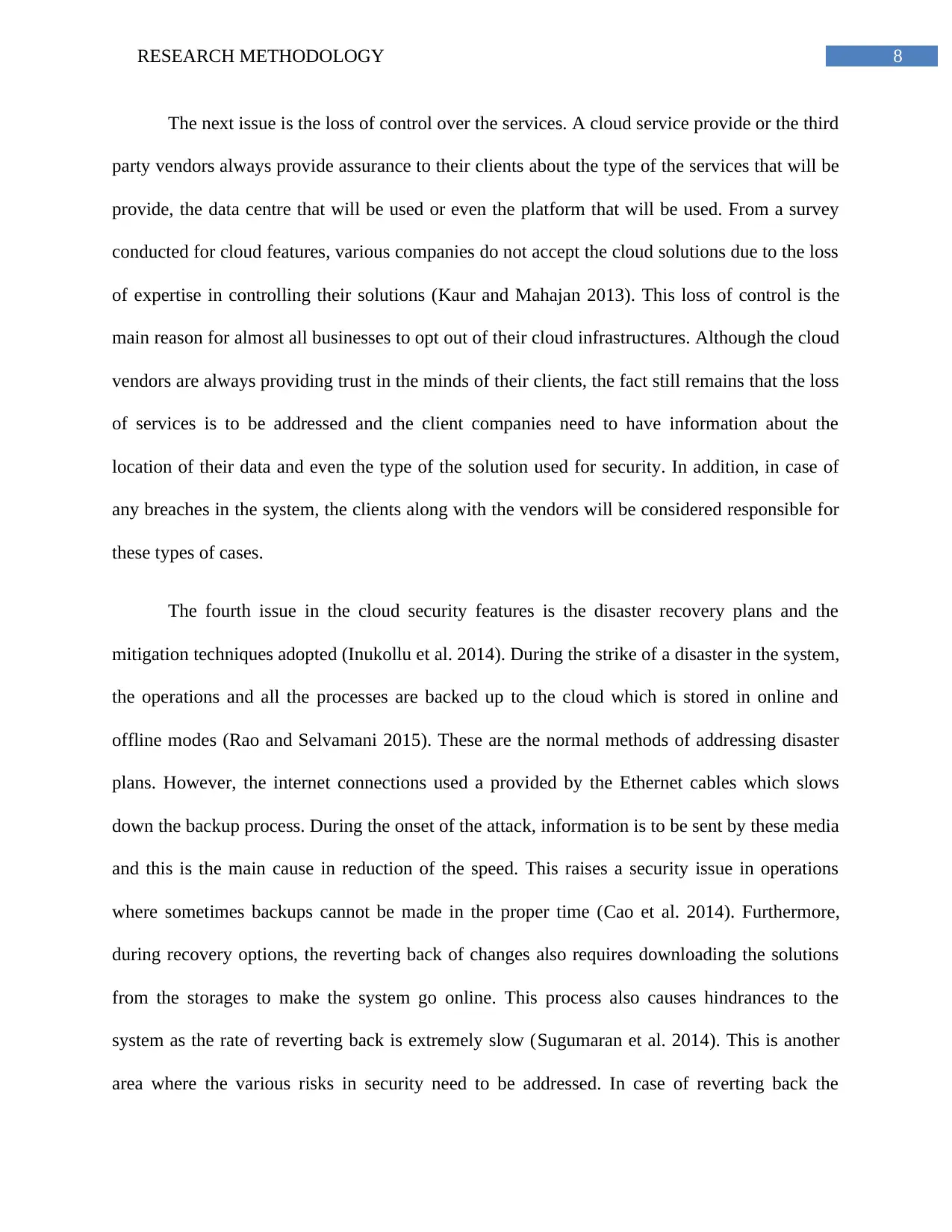
8RESEARCH METHODOLOGY
The next issue is the loss of control over the services. A cloud service provide or the third
party vendors always provide assurance to their clients about the type of the services that will be
provide, the data centre that will be used or even the platform that will be used. From a survey
conducted for cloud features, various companies do not accept the cloud solutions due to the loss
of expertise in controlling their solutions (Kaur and Mahajan 2013). This loss of control is the
main reason for almost all businesses to opt out of their cloud infrastructures. Although the cloud
vendors are always providing trust in the minds of their clients, the fact still remains that the loss
of services is to be addressed and the client companies need to have information about the
location of their data and even the type of the solution used for security. In addition, in case of
any breaches in the system, the clients along with the vendors will be considered responsible for
these types of cases.
The fourth issue in the cloud security features is the disaster recovery plans and the
mitigation techniques adopted (Inukollu et al. 2014). During the strike of a disaster in the system,
the operations and all the processes are backed up to the cloud which is stored in online and
offline modes (Rao and Selvamani 2015). These are the normal methods of addressing disaster
plans. However, the internet connections used a provided by the Ethernet cables which slows
down the backup process. During the onset of the attack, information is to be sent by these media
and this is the main cause in reduction of the speed. This raises a security issue in operations
where sometimes backups cannot be made in the proper time (Cao et al. 2014). Furthermore,
during recovery options, the reverting back of changes also requires downloading the solutions
from the storages to make the system go online. This process also causes hindrances to the
system as the rate of reverting back is extremely slow (Sugumaran et al. 2014). This is another
area where the various risks in security need to be addressed. In case of reverting back the
The next issue is the loss of control over the services. A cloud service provide or the third
party vendors always provide assurance to their clients about the type of the services that will be
provide, the data centre that will be used or even the platform that will be used. From a survey
conducted for cloud features, various companies do not accept the cloud solutions due to the loss
of expertise in controlling their solutions (Kaur and Mahajan 2013). This loss of control is the
main reason for almost all businesses to opt out of their cloud infrastructures. Although the cloud
vendors are always providing trust in the minds of their clients, the fact still remains that the loss
of services is to be addressed and the client companies need to have information about the
location of their data and even the type of the solution used for security. In addition, in case of
any breaches in the system, the clients along with the vendors will be considered responsible for
these types of cases.
The fourth issue in the cloud security features is the disaster recovery plans and the
mitigation techniques adopted (Inukollu et al. 2014). During the strike of a disaster in the system,
the operations and all the processes are backed up to the cloud which is stored in online and
offline modes (Rao and Selvamani 2015). These are the normal methods of addressing disaster
plans. However, the internet connections used a provided by the Ethernet cables which slows
down the backup process. During the onset of the attack, information is to be sent by these media
and this is the main cause in reduction of the speed. This raises a security issue in operations
where sometimes backups cannot be made in the proper time (Cao et al. 2014). Furthermore,
during recovery options, the reverting back of changes also requires downloading the solutions
from the storages to make the system go online. This process also causes hindrances to the
system as the rate of reverting back is extremely slow (Sugumaran et al. 2014). This is another
area where the various risks in security need to be addressed. In case of reverting back the
⊘ This is a preview!⊘
Do you want full access?
Subscribe today to unlock all pages.

Trusted by 1+ million students worldwide
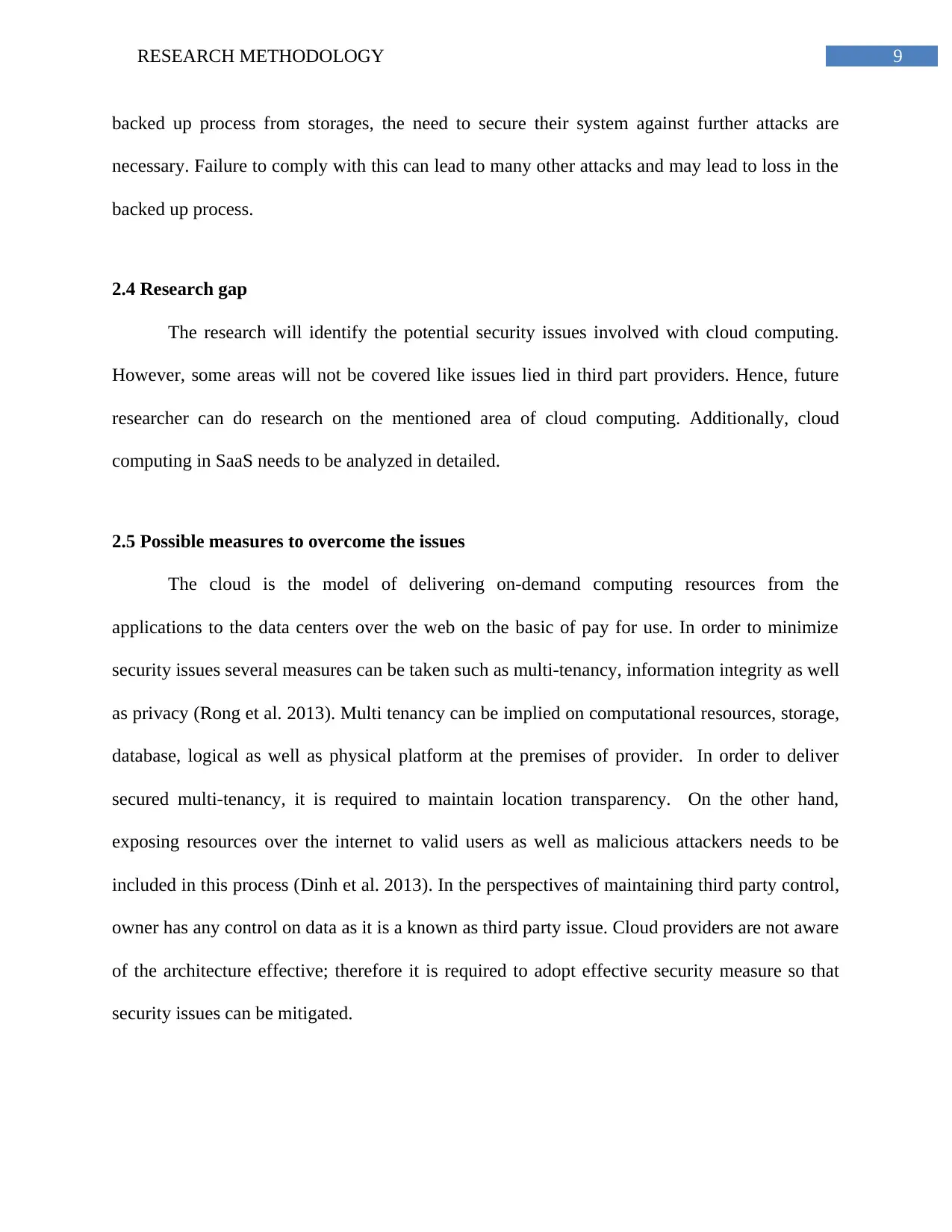
9RESEARCH METHODOLOGY
backed up process from storages, the need to secure their system against further attacks are
necessary. Failure to comply with this can lead to many other attacks and may lead to loss in the
backed up process.
2.4 Research gap
The research will identify the potential security issues involved with cloud computing.
However, some areas will not be covered like issues lied in third part providers. Hence, future
researcher can do research on the mentioned area of cloud computing. Additionally, cloud
computing in SaaS needs to be analyzed in detailed.
2.5 Possible measures to overcome the issues
The cloud is the model of delivering on-demand computing resources from the
applications to the data centers over the web on the basic of pay for use. In order to minimize
security issues several measures can be taken such as multi-tenancy, information integrity as well
as privacy (Rong et al. 2013). Multi tenancy can be implied on computational resources, storage,
database, logical as well as physical platform at the premises of provider. In order to deliver
secured multi-tenancy, it is required to maintain location transparency. On the other hand,
exposing resources over the internet to valid users as well as malicious attackers needs to be
included in this process (Dinh et al. 2013). In the perspectives of maintaining third party control,
owner has any control on data as it is a known as third party issue. Cloud providers are not aware
of the architecture effective; therefore it is required to adopt effective security measure so that
security issues can be mitigated.
backed up process from storages, the need to secure their system against further attacks are
necessary. Failure to comply with this can lead to many other attacks and may lead to loss in the
backed up process.
2.4 Research gap
The research will identify the potential security issues involved with cloud computing.
However, some areas will not be covered like issues lied in third part providers. Hence, future
researcher can do research on the mentioned area of cloud computing. Additionally, cloud
computing in SaaS needs to be analyzed in detailed.
2.5 Possible measures to overcome the issues
The cloud is the model of delivering on-demand computing resources from the
applications to the data centers over the web on the basic of pay for use. In order to minimize
security issues several measures can be taken such as multi-tenancy, information integrity as well
as privacy (Rong et al. 2013). Multi tenancy can be implied on computational resources, storage,
database, logical as well as physical platform at the premises of provider. In order to deliver
secured multi-tenancy, it is required to maintain location transparency. On the other hand,
exposing resources over the internet to valid users as well as malicious attackers needs to be
included in this process (Dinh et al. 2013). In the perspectives of maintaining third party control,
owner has any control on data as it is a known as third party issue. Cloud providers are not aware
of the architecture effective; therefore it is required to adopt effective security measure so that
security issues can be mitigated.
Paraphrase This Document
Need a fresh take? Get an instant paraphrase of this document with our AI Paraphraser
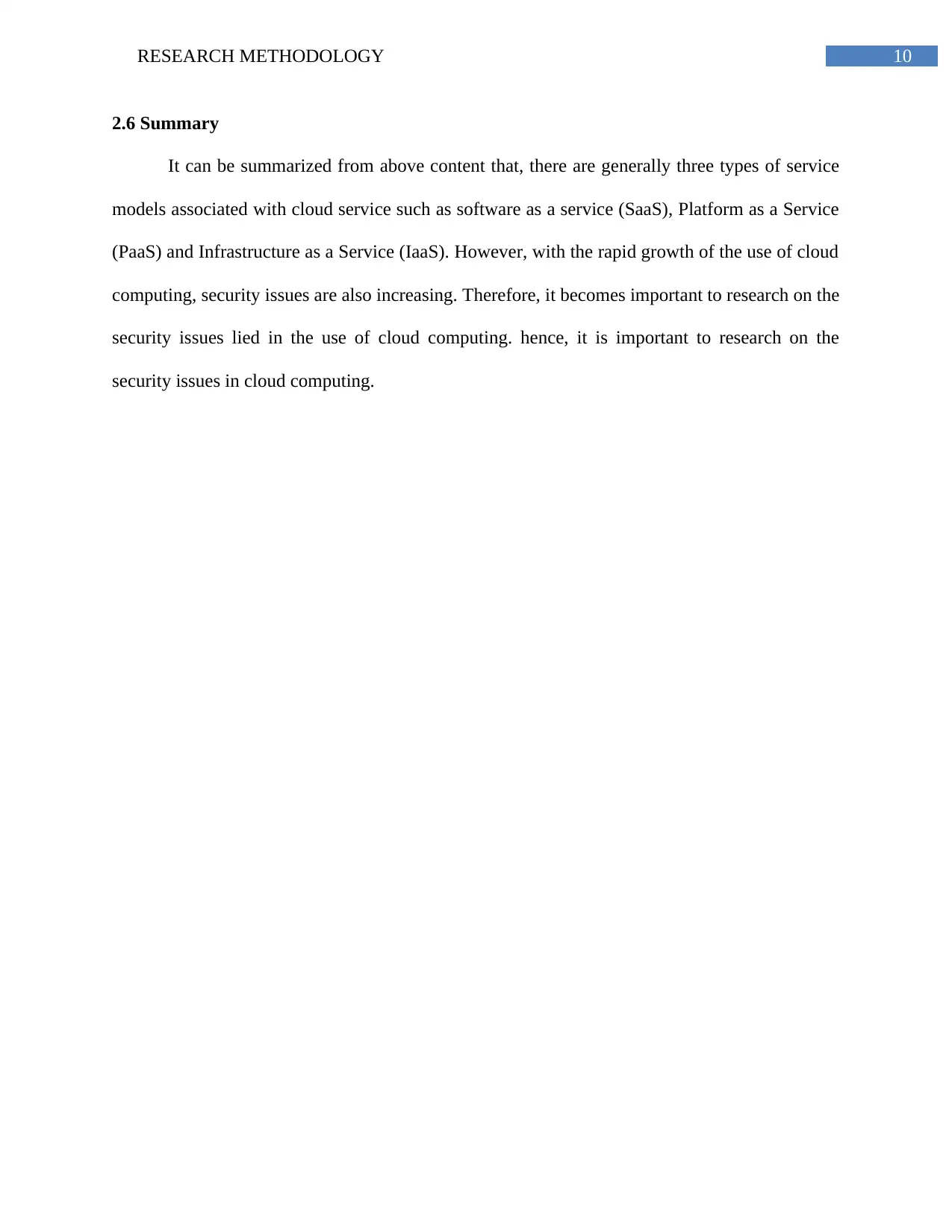
10RESEARCH METHODOLOGY
2.6 Summary
It can be summarized from above content that, there are generally three types of service
models associated with cloud service such as software as a service (SaaS), Platform as a Service
(PaaS) and Infrastructure as a Service (IaaS). However, with the rapid growth of the use of cloud
computing, security issues are also increasing. Therefore, it becomes important to research on the
security issues lied in the use of cloud computing. hence, it is important to research on the
security issues in cloud computing.
2.6 Summary
It can be summarized from above content that, there are generally three types of service
models associated with cloud service such as software as a service (SaaS), Platform as a Service
(PaaS) and Infrastructure as a Service (IaaS). However, with the rapid growth of the use of cloud
computing, security issues are also increasing. Therefore, it becomes important to research on the
security issues lied in the use of cloud computing. hence, it is important to research on the
security issues in cloud computing.
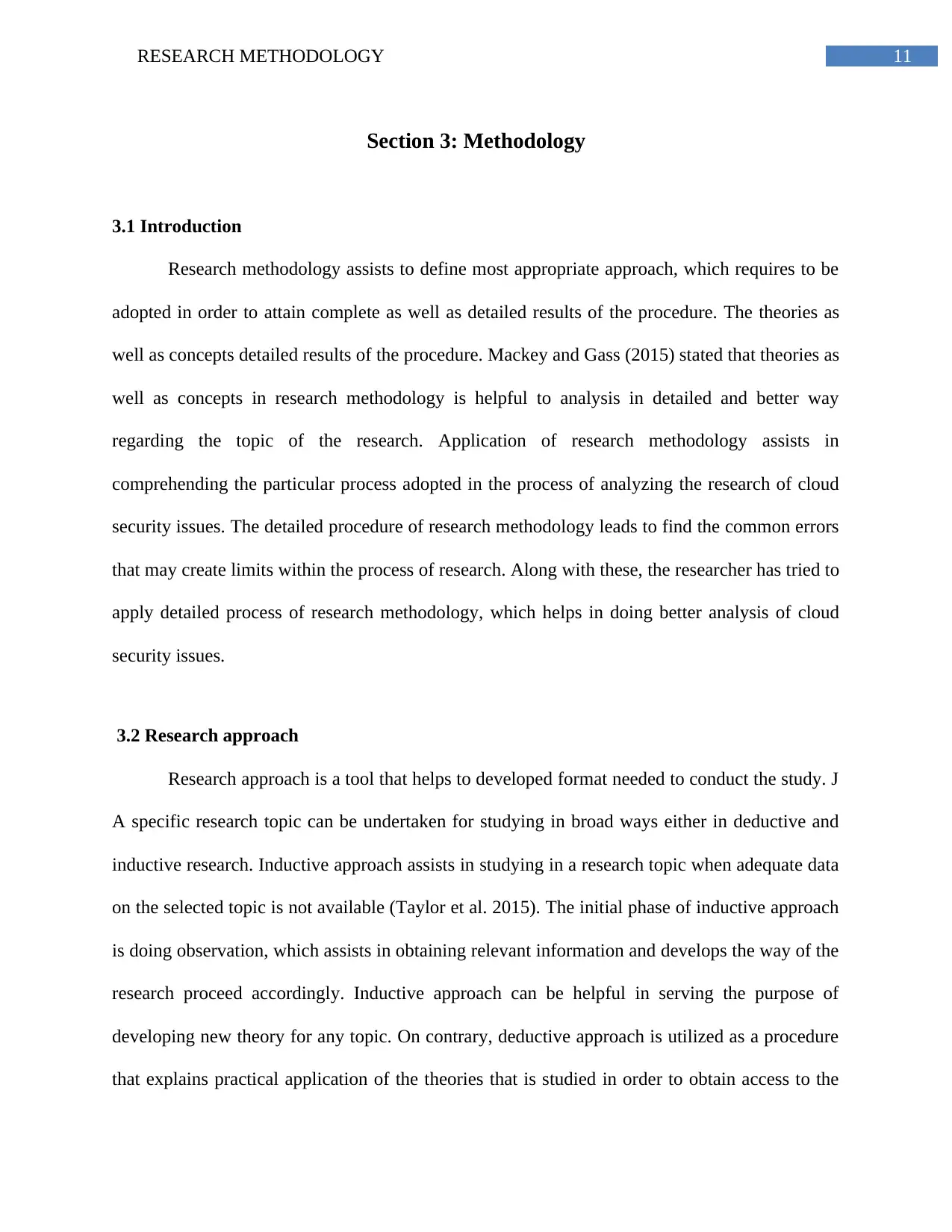
11RESEARCH METHODOLOGY
Section 3: Methodology
3.1 Introduction
Research methodology assists to define most appropriate approach, which requires to be
adopted in order to attain complete as well as detailed results of the procedure. The theories as
well as concepts detailed results of the procedure. Mackey and Gass (2015) stated that theories as
well as concepts in research methodology is helpful to analysis in detailed and better way
regarding the topic of the research. Application of research methodology assists in
comprehending the particular process adopted in the process of analyzing the research of cloud
security issues. The detailed procedure of research methodology leads to find the common errors
that may create limits within the process of research. Along with these, the researcher has tried to
apply detailed process of research methodology, which helps in doing better analysis of cloud
security issues.
3.2 Research approach
Research approach is a tool that helps to developed format needed to conduct the study. J
A specific research topic can be undertaken for studying in broad ways either in deductive and
inductive research. Inductive approach assists in studying in a research topic when adequate data
on the selected topic is not available (Taylor et al. 2015). The initial phase of inductive approach
is doing observation, which assists in obtaining relevant information and develops the way of the
research proceed accordingly. Inductive approach can be helpful in serving the purpose of
developing new theory for any topic. On contrary, deductive approach is utilized as a procedure
that explains practical application of the theories that is studied in order to obtain access to the
Section 3: Methodology
3.1 Introduction
Research methodology assists to define most appropriate approach, which requires to be
adopted in order to attain complete as well as detailed results of the procedure. The theories as
well as concepts detailed results of the procedure. Mackey and Gass (2015) stated that theories as
well as concepts in research methodology is helpful to analysis in detailed and better way
regarding the topic of the research. Application of research methodology assists in
comprehending the particular process adopted in the process of analyzing the research of cloud
security issues. The detailed procedure of research methodology leads to find the common errors
that may create limits within the process of research. Along with these, the researcher has tried to
apply detailed process of research methodology, which helps in doing better analysis of cloud
security issues.
3.2 Research approach
Research approach is a tool that helps to developed format needed to conduct the study. J
A specific research topic can be undertaken for studying in broad ways either in deductive and
inductive research. Inductive approach assists in studying in a research topic when adequate data
on the selected topic is not available (Taylor et al. 2015). The initial phase of inductive approach
is doing observation, which assists in obtaining relevant information and develops the way of the
research proceed accordingly. Inductive approach can be helpful in serving the purpose of
developing new theory for any topic. On contrary, deductive approach is utilized as a procedure
that explains practical application of the theories that is studied in order to obtain access to the
⊘ This is a preview!⊘
Do you want full access?
Subscribe today to unlock all pages.

Trusted by 1+ million students worldwide
1 out of 21
Related Documents
Your All-in-One AI-Powered Toolkit for Academic Success.
+13062052269
info@desklib.com
Available 24*7 on WhatsApp / Email
![[object Object]](/_next/static/media/star-bottom.7253800d.svg)
Unlock your academic potential
Copyright © 2020–2025 A2Z Services. All Rights Reserved. Developed and managed by ZUCOL.





